May 10
Orkney is windy. That was my first impression this morning, listening to it blow outside as we showered and went down for breakfast. My estimation of our hostess as "brusque" we entirely supported this morning at breakfast. We can down promptly at the time she suggested for breakfast on a Sunday morning, and she actually hovered around the table as we finished breakfast, waiting for us to settle up, but not actually saying anything and responding with single-word answers to our morning conversation. It was a wee bit weird. But, things were clean and reasonably comfortable (the bed was thin) and breakfast was hearty.
Every guidebooks warned us to get to Maes Howe early -- during busy times, there can be a long wait to get into the burial mound, and since only a fixed number of people are allowed in each day, earlier is better. Which is how we ended up arriving too early to get tickets. The office is in a restored mill building just across the road from the quite-unimpressive looking hill that is the burial mound, and it a historical site in its own right. There is a small museum upstairs that is worth a quick walk through. Since we had a half hour or so before we could even get tickets, we drove back to the Ring of Brodgar for some further pictures.
Archeological finds and farm fields - who wins?
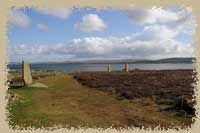 The ring is another weird field of stones -- concentric circles of flat slabs of stone (much like larger version sof the Stones of Stennis, although the stones themselves are not quite as large). Once again, I am struck by the impossibility of recognizing this enormous string of stones as anything in particular when they were discovered…many were not standing, and whoever dug up the first few could not possibly have seen the pattern right away. There are so many Neolithic burials here that every single slight mound in a field probably hides a burial cist or cairn of stones or something even more interesting. I wonder what he thought, the farmer who ran across the first couple of stones? Probably cursed the necessity of having to move them out of his field, and was even more annoyed when he realized that they were "important' and he wasn't going to be able to plow the field at all. Murrains, they are! Nothing more than glacial deposits!
The ring is another weird field of stones -- concentric circles of flat slabs of stone (much like larger version sof the Stones of Stennis, although the stones themselves are not quite as large). Once again, I am struck by the impossibility of recognizing this enormous string of stones as anything in particular when they were discovered…many were not standing, and whoever dug up the first few could not possibly have seen the pattern right away. There are so many Neolithic burials here that every single slight mound in a field probably hides a burial cist or cairn of stones or something even more interesting. I wonder what he thought, the farmer who ran across the first couple of stones? Probably cursed the necessity of having to move them out of his field, and was even more annoyed when he realized that they were "important' and he wasn't going to be able to plow the field at all. Murrains, they are! Nothing more than glacial deposits!
It does make me wonder what the rules are regarding archaeological finds. I assume that people have to report anything odd, but does the government then take over the site? Do people get paid for it? Or is that all a pipe dream and there really isn't any specific rule? I can easily imagine the a farmer discovering a pile of rocks in his field, or digging up something interesting, having zero incentive to report it to anyone, if the end result t is that he no longer can farm that land or build on it. Maybe it's not as big a deal today as it would have been in the last century--most of the land on these islands has been plowed, I think. Of course, now that we've seen some of the cairns and settlements, every mound of earth is suspect, every rolling field could be a trove of Neolithic cairns, every exposed stone is evocative of a different age. It's rather romantic. I'm left to wonder just how much more there is to find beneath the windblown hills and sandy beaches.
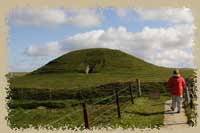 The weather cleared to a lovely (but chilly) wind as we got our tickets to Maes Howe and followed the carefully-labeled walkway across the main road to the site. I mention 'carefully labeled' because there was apparently a recent effort by the Orkney council (I'm not sure if it's the tourist board or some other entity) to address safety issues and the earlier practice of just traipsing across the two-lane road willy nilly was apparently deemed "too dangerous". We were instructed to follow the painted path, behind the wall, and to cross only at the well-marked crossing down the road. I had to admit that we had a bit of a giggle about the whole thing…the road, while it is the main road on the island, is a two-lane, rural route that has very little traffic and what traffic there is can be seen for at least a mile in each direction. Safety? I can't imagine that it could be any safer unless they built an overpass. Maybe this really is a problem in the high season, when hundreds of tourists descend every hour, but now, in May, the ten of us are the only people we can see. We chuckled again when we realized that all of us had obediently followed the path and even looked both ways on the deserted road.
The weather cleared to a lovely (but chilly) wind as we got our tickets to Maes Howe and followed the carefully-labeled walkway across the main road to the site. I mention 'carefully labeled' because there was apparently a recent effort by the Orkney council (I'm not sure if it's the tourist board or some other entity) to address safety issues and the earlier practice of just traipsing across the two-lane road willy nilly was apparently deemed "too dangerous". We were instructed to follow the painted path, behind the wall, and to cross only at the well-marked crossing down the road. I had to admit that we had a bit of a giggle about the whole thing…the road, while it is the main road on the island, is a two-lane, rural route that has very little traffic and what traffic there is can be seen for at least a mile in each direction. Safety? I can't imagine that it could be any safer unless they built an overpass. Maybe this really is a problem in the high season, when hundreds of tourists descend every hour, but now, in May, the ten of us are the only people we can see. We chuckled again when we realized that all of us had obediently followed the path and even looked both ways on the deserted road.
The Neolithic tomb at Maes Howe is absolutely unremarkable from the outside -- a small rounded mound would barely qualify as a hillock. The small stone entryway leads to a small square chamber that is renowned for its Viking runic graffiti even more than for its Neolithic origins. Our guide was great -- he managed to condense Neolithic history on the Orkneys, Viking history, and the modern re-discovery of the tomb into a roughly 45-minute presentation. No one really knows the "why" of some of the architectural details in the tomb, but the stories behind the runes and a number of theories about what the tomb was used for were very interesting. It was hellish for me, though -- no touching allowed. I'm a compulsive touchier (and I spend a lot of my vacations with my hands shoved in my pockets to avoid touching things in museums and at historical sites).
I was surprised at how large the chamber inside was compared to the size of the mound -- the sites of Newgrange and Knowth and Dowth in Ireland are the same sort of structure - in each case, the interior chambers are quite small and the mounds themselves are enormous, Newgrange and Maes Howe both capture the path of the sun (well, they're a bit off now, several thousand years later). I don't see any indication that Maes Howe was any larger, though. It's an interesting comparison, and the same theories and conjectures apply to each site. Burial mound? Ritual solstice site? Religious site? None of the above? No one has the answers, of course.
Gale force winds, no trees, and neolithic houses. Woot!
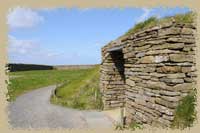 One of the most visited sites in the Orkneys (and often the single site visited by day-trippers) is the Neolithic settlement of Skara Brae. The cluster of round stone houses and shops clustered around central passageways was only discovered in the last century after a huge storm blew away the sand dunes that had buried the site for millennia. The houses are surprisingly cozy and despite the fact that everything is made from stone, they would have been quite comfortable. Stone bedsteads filled with furs, straw or grass, stone shelves, seating and tables. The path around the site walks along the tops of the different excavated spaces - looking down into the round holes is a difficult perspective, so they have provided a reconstruction of one of the houses with its stretched hide roof and household items included. We were a bit relieved that there weren't mock-ups of people mad out of papier mache or plaster hanging around. They always creep me out.
One of the most visited sites in the Orkneys (and often the single site visited by day-trippers) is the Neolithic settlement of Skara Brae. The cluster of round stone houses and shops clustered around central passageways was only discovered in the last century after a huge storm blew away the sand dunes that had buried the site for millennia. The houses are surprisingly cozy and despite the fact that everything is made from stone, they would have been quite comfortable. Stone bedsteads filled with furs, straw or grass, stone shelves, seating and tables. The path around the site walks along the tops of the different excavated spaces - looking down into the round holes is a difficult perspective, so they have provided a reconstruction of one of the houses with its stretched hide roof and household items included. We were a bit relieved that there weren't mock-ups of people mad out of papier mache or plaster hanging around. They always creep me out.
We stopped to talk to the Historic Scotland guide who stood on the top of the wall, buffeted by the increasingly gale-like winds. He told us that they were sure that the settlement extended further out from the shoreline and there were probably dozens of other 'houses' scattered over the landscape. Most of them haven't even been touched yet. In fact, he told us, the population of the islands in Neolithic times was probably not that much smaller than it is today - hardy souls living off the sea and learning to deal with the wind and weather that still punish the coast. "Jus t a bit of a breeze!" he said, as we shouted above the noise.
He told us a rather interesting story of a stone cairn dug up "just down the road a bit" that contained a huge skeleton - over 7 feet tall -- with two rows of teeth, and when they discovered it they all stood around for a moment with their shovels, and then decided to "just cover him back up!". No harm, no foul. I never did find any mention of this double-toothed giant, but it was a good tale, nonetheless.
The other revelation? He explained that everything was made with stone and only tiny bits of driftwood because there were no trees on the islands. I honestly hadn't noticed until that very moment, but if you stand on high ground and look around…no trees. Oh, a few shrubby ones in people's yards, but trees are almost entirely missing from the landscape here. Not only were they cut down to build the few things requiring wood, but the harsh weather prevents them from really taking root anywhere. Weird.
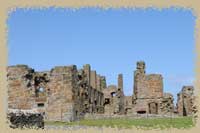 We stopped for lunch in the café (had a very odd hamburger, but getting in out of the wind and having some soup was a nice relief). We didn't walk over to the medieval tower house associated with the site (it is included in the entry fee to Skara Brae), but we did spend al little time looking at the small display inside the new welcome center before we drove up the coast to Birsay to see the remains of the Earl's Palace there and possibly go out to the Broch of Birsay. We missed the tide, of course - too high to get out on the causeway to see the Neolithic broch, but the Earl's Palace (really a large medieval house) is quite interesting. It sits in the middle of a warehouse district, hemmed in by metal buildings and truck loading docs. We basked in the sun for a bit, imagining the large, paved courtyard and comfortable rooms lining the walls, and then drove back into Kirkwall to see the town.
We stopped for lunch in the café (had a very odd hamburger, but getting in out of the wind and having some soup was a nice relief). We didn't walk over to the medieval tower house associated with the site (it is included in the entry fee to Skara Brae), but we did spend al little time looking at the small display inside the new welcome center before we drove up the coast to Birsay to see the remains of the Earl's Palace there and possibly go out to the Broch of Birsay. We missed the tide, of course - too high to get out on the causeway to see the Neolithic broch, but the Earl's Palace (really a large medieval house) is quite interesting. It sits in the middle of a warehouse district, hemmed in by metal buildings and truck loading docs. We basked in the sun for a bit, imagining the large, paved courtyard and comfortable rooms lining the walls, and then drove back into Kirkwall to see the town.
Viking cathedrals? They build those?
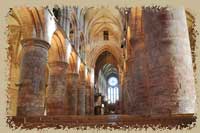 Kirkwall is an interesting town, with lots of curving streets and brick buildings. We parked opposite the huge Cathedral of St Magnus, one of the major attractions in the town. The enormous red-and-white sandstone building was built by Vikings. The alternating use of red sandstone blocks and white blocks is very striking, and the cathedral itself is a huge, stocky church with enormous round columns, but surprisingly delicate arches inside. The church is still in use, modern wooden pews and plastic chairs in neat rows between the slightly leaning original pillars.
Kirkwall is an interesting town, with lots of curving streets and brick buildings. We parked opposite the huge Cathedral of St Magnus, one of the major attractions in the town. The enormous red-and-white sandstone building was built by Vikings. The alternating use of red sandstone blocks and white blocks is very striking, and the cathedral itself is a huge, stocky church with enormous round columns, but surprisingly delicate arches inside. The church is still in use, modern wooden pews and plastic chairs in neat rows between the slightly leaning original pillars.
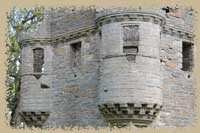 Across the street is another Earl's Palace - and perhaps one of the most remarkable buildings we've seen so far. The palace is billed as the 'finest Renaissance building in Scotland' and it is startlingly modern - large rooms with big oriel windows and overhanging bays, wide staircases, and comfortable bedrooms. Cover it with a layer of modern stucco and add glass to the tall, narrow windows, and it would be entirely livable. Well, a bit chilly, perhaps. And that lack of plumbing would probably turn off a modern buyer.
Across the street is another Earl's Palace - and perhaps one of the most remarkable buildings we've seen so far. The palace is billed as the 'finest Renaissance building in Scotland' and it is startlingly modern - large rooms with big oriel windows and overhanging bays, wide staircases, and comfortable bedrooms. Cover it with a layer of modern stucco and add glass to the tall, narrow windows, and it would be entirely livable. Well, a bit chilly, perhaps. And that lack of plumbing would probably turn off a modern buyer.
There is a small ruin across the alley, a Bishop's Palace - much less grand, much less imposing than the Earl across the street. Not much is left but the shell, and the towering stair looking out over the cathedral. I wonder if the poor bishop looked across at the splendid house of the Earl and wished he'd made a few different choices in his life and career. I know I would have. Sitting in my little garret room, looking across at the lights and entertainments that were likely held by the Earl, I'd have been pretty sour on my own less elegant estate.
It was still early enough that we tried to get to Mine Howe -- another Neolithic cist burial -- and while we arrived in time based on their posted opening hours..they were closed. They SAID they were open until 3, but apparently it was a slow day. Actually, it's more likely that those were summer hours. We snapped a picture of the mound (ooh, how interesting from the outside. Not) and decided to try to go on the distillery tour at Highland Park.
We missed the last tour, but spent a lovely half hour with the staff and they shared a dram with us anyway. We watched the film on Orkney whisky and bought another bottle of whisky to take home (21 year old Highland Park) and a few whiskey glasses. Everyone was really nice and even offered to run us on a quick tour by ourselves if we could wait for the tour guide to come back from the last group. Unfortunately, that would have made us a bit late to the ferry (or we thought it would, in hindsight, we'd have been fine). The Orkneys were the one place where our time estimates were quite accurate -- there is almost no traffic, and the main roads are straight long each island and pass through the major towns and sites without much detouring.
Remnants of WWII
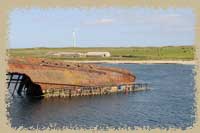 I took a few pictures of the Churchill Barriers for Scapa Flow (after Mark assured me that it wasn't necessary to see the base itself, even if that were possible). Mostly, these are just sunken ships and concrete blocks strewn in the gaps between the islands to protect passage through them. The road is built on the concrete pilings and the rusted hulks of ships jut from the water at each crossing. Mark is fantastically interested din this sort of thing, and is spouting all sorts of facts and figures about the naval base here.
I took a few pictures of the Churchill Barriers for Scapa Flow (after Mark assured me that it wasn't necessary to see the base itself, even if that were possible). Mostly, these are just sunken ships and concrete blocks strewn in the gaps between the islands to protect passage through them. The road is built on the concrete pilings and the rusted hulks of ships jut from the water at each crossing. Mark is fantastically interested din this sort of thing, and is spouting all sorts of facts and figures about the naval base here.
We made two detours on the way to the ferry -- we spied a sign for Orkney Wine. Yes, wine. We bought a bottle of Gorse Flower wine, which I am sure is going to be the worst bottle of wine we've ever tasted, but…it's from Orkney. No one will believe it. We also took stopped to see the Italian Chapel--really a Quonset hut (a half-round metal culvert) that was painted inside by Italian POWs. The trompe l'oiel chapel inside is amazing - faux stone work, painted vaulting, detailed sculptures leading to a lovely altarpiece. It's unexpected and charming.
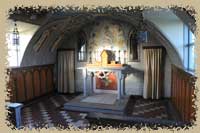 We left from St. Margaret's Hope, a picturesque little town, and napped on the ferry ride back to the mainland. Our B&B for the night is Bilbster House near Wick. Lovely old Georgian House, and a voluble host who gave good directions ("CROSS THE RIVER IN WICK! I don't care what your satnav says!") and who was then even more helpful in pointing us to restaurants in Wick for dinner via a couple of a maps and an aerial photograph of the town. We opted for Bistro One -- a teeny hotel restaurants on the shortest street in the world (as confirmed by the Guinness Book of World Records). The street, which has its own name, is just about the width of the door to the restaurant.
We left from St. Margaret's Hope, a picturesque little town, and napped on the ferry ride back to the mainland. Our B&B for the night is Bilbster House near Wick. Lovely old Georgian House, and a voluble host who gave good directions ("CROSS THE RIVER IN WICK! I don't care what your satnav says!") and who was then even more helpful in pointing us to restaurants in Wick for dinner via a couple of a maps and an aerial photograph of the town. We opted for Bistro One -- a teeny hotel restaurants on the shortest street in the world (as confirmed by the Guinness Book of World Records). The street, which has its own name, is just about the width of the door to the restaurant.
Historic Building rules
We slept like rocks in the too-small bed, bundled under layers of down and blankets. It wasn't the most comfortable of nights, but our host made up for it in the morning by talking about his renovation of the house and the trials and tribulations of dealing with the historic boards about what sorts of changes one could make. Apparently, the effort of putting downspouts on the old house to eliminate the water damage from the roof runoff. First, they didn't want any, it wasn't "historical", then they balked at square downspouts, and were only swayed by the flat assertion that doing nothing was going to bring the house down to rubble. Must have cast-iron skylights -- even if they rust and cause more problems than look-alikes. There comes a point where historical accuracy needs to be bent a little to ensure that the building itself will survive. The "purists" who insist that you must absolutely not upgrade or change any part of an old building may one day be responsible for losing many of the beautiful old houses in Scotland, our host argues. I'm inclined to agree.
I'm an old-house bigot -- I love old houses, and staying in some of these great centuries-old houses. The architecture is fascinating, the character shines through year sof bad decorating and patchwork repairs in some cases, other are museum-piece restorations with antique furniture and renaissance plaster techniques. Most homeowners are just trying to keep out the damp and keep the stone piles standing -- if the plastwork is not exactly as a 17th century artisan would do it, but as long as no one guts the house and puts in plasticine moldings and hollow-core doors, I really think the intent is enough. Especially when you consider the cost of some of the repairs. There are reasons we have moved to double-pane glass and deadbolt locks. Technology can be a good thing.
Of course, new technology is not always the answer -- we think that we're so much more advanced than the stonemasons and builders who erected these old houses and towers, and yet we can made decisions about restoration and repair that actually cause more damage: case in point? Craigievar Castle. Restoration experts in the 60s decided that concrete would be the perfect harling material -- waterproof, modern, it would solve the water issue that all old tower houses have. Nope. In fact, sealing in the stone with modern concrete made the problem much worse; the stone couldn't breathe, water was retained in the building, and damp and running water were greater than before. The old stonemasons knew exactly what they were doing when they used a lime-based harling. It breathes, it flexes, it is the perfect "skin". We cannot assume that a "modern" method is automatically better than the ancient methods, but neither can we be locked into the ancient methods. The balancing act has to be difficult.

